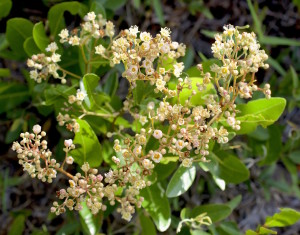
Gopher Apples are blossoming now so look for them in pine scrubs, about a foot high resembling young oaks. Watch them closely. In six to eight week they’ll have pasty pink and gray fruit the size of large olives. The woodland creatures relish them and will beat you to them if they can. Photo by Green Deane
Locally May is a transition month. Many of our local winter foragables are ending their prime season — sow thistles are a good example — and others are just starting such as Groundnuts. Both of these are found throughout most of North America thus can be in season someplace nearly all year. Here their seasons are about half-a-year off from what one would find in northern climates such as Canada.
With classes last week on both sides of the state there was a lot of transitioning to be seen. The aforementioned Groundnuts are starting to blossom, which makes them a bit easier for novices to find. While they have leaflets of 3, 5, and 7 leaves — occasionally 9 — they are otherwise nondescript until they bloom. The deep magenta blossoms get about an inch across and have the classic “wings & keels” one would expect of a plant in the pea family. As pleasing as they are on the eye these blossoms are not pleasant on the nose. It’s an aroma only certain bugs can love. The flowers eventually turn into pea pods and the peas are edible cooked. However, most people don’t eat the seeds: They want the plant’s tasty and nutritious root. The seeds or the roots can be used for propagation and although the Groundnut competes in damp spots it will adapt to your home garden. To read more about the Groundnut, go here.
In the realm of plant populations there is endangered, threatened then rare. But there is a huge distance between rare and common. The yellow bloomer to the right — Candyroot — is not on any about-to-disappear list but one doesn’t see them that often. You have to be at the right place — seasonally damp pine scrub — and the right season, May in Florida but it can be found later in the year. Candyroot comes in two colors, yellow that can sometimes make it to orange. Native Americans and early Europeans would chew the roots, which have a spearmint-esque flavor, or wintergreen, and to some palates licorice. The tap root is also rather small, so it’s not much of a chew. Kind of like a woodland breath mint. To read more about Candyroot you can click here.
There are blue blueberries, and there are black blueberries… and there are black and blue huckleberries which are blueberries’ first cousins, so to speak. They’re all tasty and good for you. There are two things you need to remember about blueberries (and huckleberries.) The first is they like acidic soil. Where I grew up in Maine one could find 40-acre fields of nothing but blueberries (with few huckleberry bushes in the transition zone to trees.) Locally the place to look for blueberries is open pine scrub, or near small oaks. Both create acidic soil. Big oaks often create too much shade for the blueberries to thrive. The second thing to remember is these berries are “crown” berries (the outer top surface of the berry looks like a little stylized crown. See above left.) There are no toxic “crown” berries. Some might be woody or bitter but there aren’t any toxic ones. To read more about blueberries go here, or huckleberries, here.
In the sub-tropical southern end of the state Simpson Stoppers are blossoming. They will in time create twin orange-colored berries which when dead ripe have edible pulp. It’s not for everyone. They grow farther north and as natives are being promoted in landscaping and the like. I even know where there’s a quarter-mile long hedge of them. But before blossoming and fruiting the stoppers can be difficult to sort out. There about a dozen and a half of them and they range from pleasant smelling to I-wish-I-hadn’t-smelled-that. One way to make sure you have a Simpson Stopper — which has had more botanical names than any other shrub — is to survey the leaves. Only the stopper has notched leaves, round tip leaves, and pointed leaves. It’s not always easy to find all three types but if you study the shrub you can identify them. You can read about the stopper here.
When is Wild Coffee not wild coffee? When it is the Coralberry. Both plants look similar from a distance. But as the saying goes no two plants look alike if you get close enough. Wild Coffee, Psychotria nervosa, is extremely over-rated in foraging publications. Anyone who writes you can roast the seeds like coffee and drink it like coffee has never tried it… or coffee… Thus the seeds are out. That leaves the seed pulp which is mild but edible. Opinion on just what that flavor is varies greatly. It’s a trail-side nibble when you are on the coast. See that emphasis. Wild Coffee is usually found on the coast (which includes a few miles inland.) It is usually not found in the middle of the state. That is where you find the Coralberry.
The Coralberry, Ardisia crenata, is an extremely invasive species. It greatly reminds one of the Wild Coffee but there are significant difference including that — currently — the Coralberry is found way inland, in the center part of the state. It also has less prominent leaf veins and blunt teeth around the leaf edge, which is what “crenate” means. The Wild Coffee leaf does not have any teeth. Is the pulp of the Coralberry edible? I will say no. The plant has been implicated in cattle poisoning, but they tend to eat leaves, steams and seeds. And there are some shrubs in Florida in the same genus — Ardisia — which have barely edible berries. I will report I ate the pulp off one Ardisia crenata berry. It tasted like green peas and had no immediate or long-lasting effects that I know of. But I don’t recommend doing that.
My upcoming foraging classes. This weekend I’ll be at Mead Garden which can have over 100 different edible species in about 1.5 mile walk. In Jacksonville we cover about two miles and seem some tropicals not found this far north. These classes aren’t classroom frou-frou. We get out and about the plants.
Saturday May 23rd, Mead Garden: 1500 S. Denning Dr., Winter Park, FL 32789, 9 a.m.
Sunday, May 24th, Florida State College, 11901 Beach Blvd., Jacksonville, 32246. 9 a.m.
Sunday, May 31st, Dreher Park, 1200 Southern Blvd., West Palm Beach, 33405, 9 a.m.
Sunday, June 7th, Bayshore Live Oak Park, 23000 Bayshore Rd., Port Charlotte, FL 33980. 9 a.m.
Saturday, June 13th, Mead Garden: 1500 S. Denning Dr., Winter Park, FL 32789, 9. a.m.
Sunday, June 14th, Red Bug Slough Preserve, 5200 Beneva Road, Sarasota, FL, 34233, 9 a.m.
Sunday, June 21st, John Chestnut County Park: 2200 East Lake Road, Palm Harbor, FL 34685 9 a.m.
Saturday, June 27th, Boulware Springs Park, 3420 SE 15th St., Gainesville, FL 32641 9 a.m.
Sunday, June 28th, Jervey Gantt Recreation Complex, 2390 SE 36th Ave., Ocala, FL, 34471, 9 a.m.
For more information about foraging classes go here.
Need to identify a plant? Looking for a foraging reference? Maybe you have a UFO, an Unidentified Flowering Object, you want identified. On the Green Deane Forum we — including Green Deane — chat about foraging all year long. And it’s not just about warm-weather plants or just North American flora. Many nations share common weeds so there’s a lot to talk about. There’s also more than weeds. The reference section has information for foraging around the world. There are articles on food preservation, and forgotten skills from making bows to fermenting food. Recent topics include: Cultivated Apios Americana: Groundnut, My First Pokeweed, Yaupon Holly? Plantain? Sand Toads? Will My Tomatoes Make Me Pregnant? White BUgs on Smilax Tips, Poison Hemlock and Eating Birds, Study and Respect Plants, Firebow Elderberry, Not Yellow Pimpernel, Small Purple Flowers, Firebow Baccharis, Milkweed? Elderflower Fritters, Fuzzy Tree, Lacto-Fermenting Stachys Roots, Sweet Aromatic Herb, New Book: Southeast Foraging, and Hibiscus Help. You can join the forum by clicking on the button on the upper right hand side of this page.
Subscribe to Green Deane’s weekly EatTheWeeds newsletter, upper right side of this page.

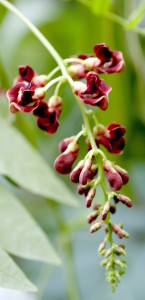
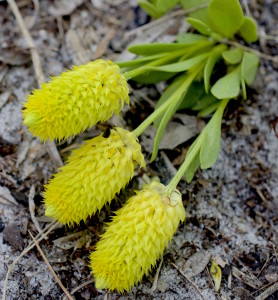
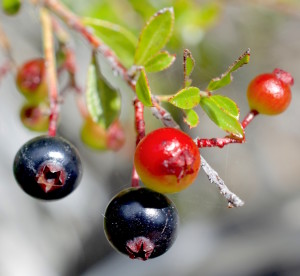
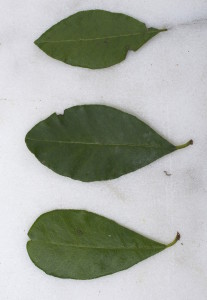

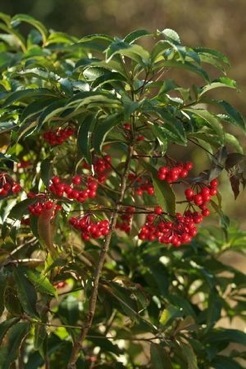
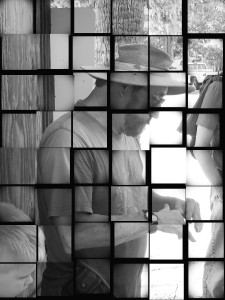
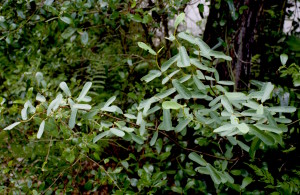

I have what I believe to be groundnut growing. However, I’d appreciate a picture of the root for positive identifying. Mine is shaped similar to a football.
If you go to the parent website, EatTheWeeds.com and type apios into the search window it will take you to my page on them. I also ahve two videos on You Tube. Type in apios and Green Deane
Thanks for posting the name of the mystery botanical, glad to know I got it right last newsletter.
First “Candy” is a lovely word; hence let me start with the quote of Candy Polar though I couldn’t identify the character. “ Alone with myself…The trees bend to caress me…The shade hugs my heart.”
Then to “Candy Root” about which I confess I’m hesitant to write about taking in consideration I’m not sure of its occurrence here in in Sudan. Time and again, I’ve kept referring to your article to check if I’m on the right track. Now, before me are three plants belonging to different families, namely: a/ Polygala lutea of family Polygalacaea, b/ Althea glabra of family Malvacaea, and c/ Glycyrrhiza glabra of family Fabacaea. According to my knowledge, all have sweet roots of much important medicinal use; but the main chemical constituents in these roots are different. As I’ve found there is some confusion in our Middle East Countries concerning b and c ; eg. In an Arabic report (I assume a translation) the root of c is said to have the constituent “Irg el Souse” – Egyptian vernacular by which is meant – or better implied – the compound glycerrhizin. I’ve concluded that by” liquorice, or licorice” is meant the root of G. glabra from which a sweet flavour can be extracted. In addition, it is known that the ancient Egyptians (3000 years ago ) made candy from the root of Marshmallow “Althea officinalis” plant. Liquorice is very popular in Egypt and Syria where it is sold as a drink in shops and street vendors. Personally , like most tourists, I had enjoyed drinking liquorice and keep remembering the vendor sellers singing and praising the medicinal benefits of their commodity while holding and supporting the big jar container by the one hand and clapping on two shiny metallic cups by the other – almost magic.